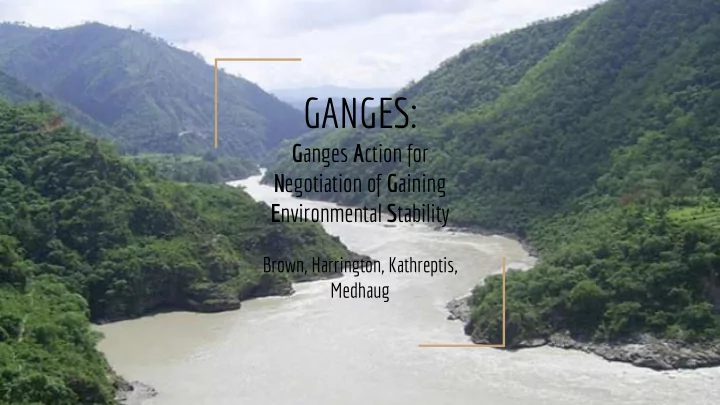

GANGES: G anges A ction for N egotiation of G aining E nvironmental S tability Brown, Harrington, Kathreptis, Medhaug
Background and History The Ganges River Basin is a transboundary basin, it is shared amongst ● India, Nepal, Bangladesh, and China. Due to the large acreage of the basin, our report focuses on the Ganges ● River in Northern India, between the highly polluted cities of Kanpur and Varanasi. To Hindus, the Ganges is sacred. The river is the embodiment of the ● Goddess, Ganga. The water is believed to cleanse the soul and heal the body. Hindus use the water to cleanse products, drink the water to help with ● illnesses and it is used for rituals and ceremonies.
Background Continued India gained its independence from Great Britain on August 15, 1947. ● Congress adopted a policy of economic liberalization. After this shift from ● an agricultural economy to an industrial one, the private sector expanded electricity generation, chemical, coal, oil, and mining industries. This resulted in a population increase, a population shift to cities, and an ● increase in waste production. Stockholm conference occurred which prompted India to develop ● environmental policy. The Water (Prevention & Control of Pollution) Act of 1974, became the ● first legislation in India to address water pollution. The purpose of the act is to provide for the prevention and control of water pollution, and for the maintaining or restoring the quality of water in the country.
Mission The GANGES mission is to educate the public on the value of clean water in an attempt to reduce anthropogenic sources of pollution, to determine a more productive way to irrigate crops, and to protect the endangered species in India and Bangladesh, by 2038.
Problem 1: Water Diversion Issue: India uses 30 water diversion practices along the Ganges. Downstream of such practices, Bangladesh is suffering. Solution: Remove dams ● Install water catchment systems ●
Problem 2: Anthropogenic Pollution Issue: The Ganges river is a common location for disposal of domestic waste and raw sewage, cremation ashes for religious purposes, and toxic waste disposal. Solution: Education ● Develop a toxic waste collection ● Washington Post, photo by: (Danish Siddiqui/Reuters) system
Problem 3: Endangered Species Issue: The Ganges river has a high biodiversity, but it is threatened by overfishing, invasive species, and water quality. Solution: Enforce fishing restrictions
Goals Reduce Water Diversion ● Increase river flow by removing dams ○ Educate public about sustainable water ○ practices Specifically farmers → drip irrigation ■ Reduce Anthropogenic Pollution ● Reduce pathogenic inputs into the river → ○ decrease stagnation Protect Stream Habitat ● Promote education on endangered species ○ World Atlas, 2017. Prevent ecosystem degradation ○
Works Cited Slide 6 photo: https://www.washingtonpost.com/news/in-sight/wp/2017/07/14/the-ganges-is -our-mother-there-wont-be-any-future-if-she-dies/?utm_term=.5b7d2dd08e02 Slide 8 photo: https://www.worldatlas.com/articles/where-does-the-ganges-river-flow.html
Recommend
More recommend